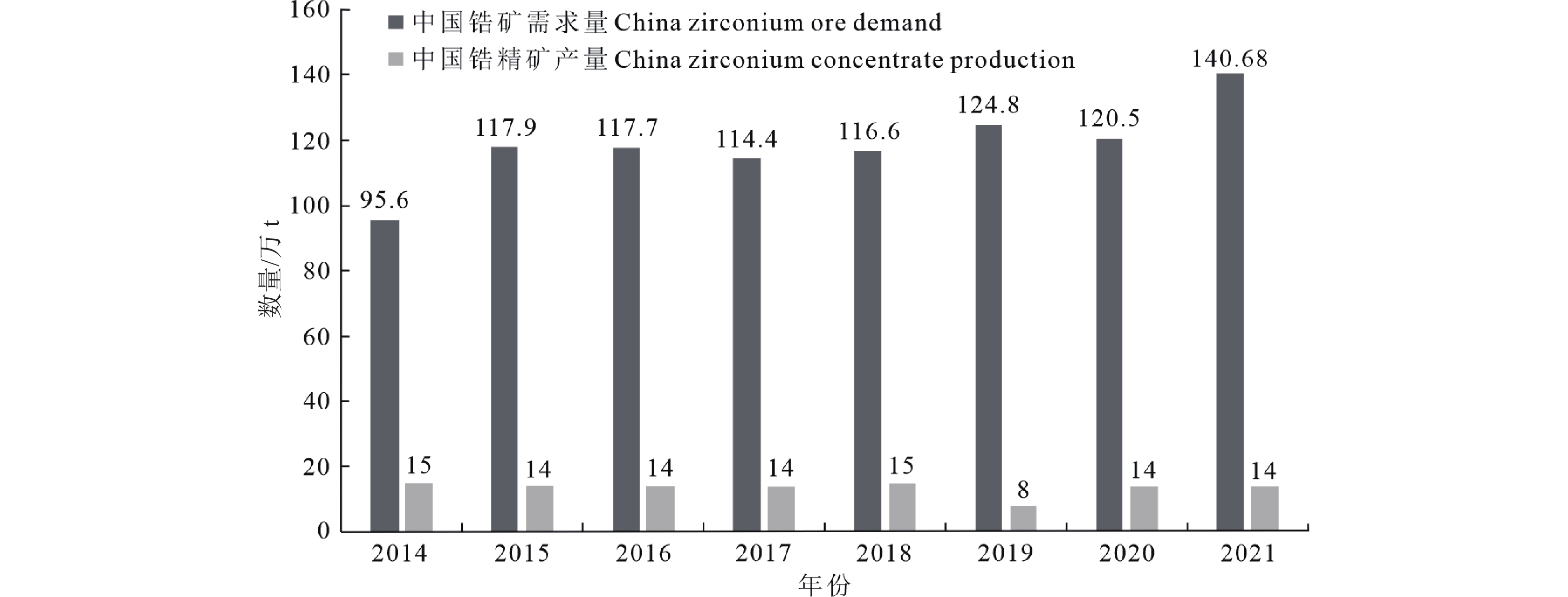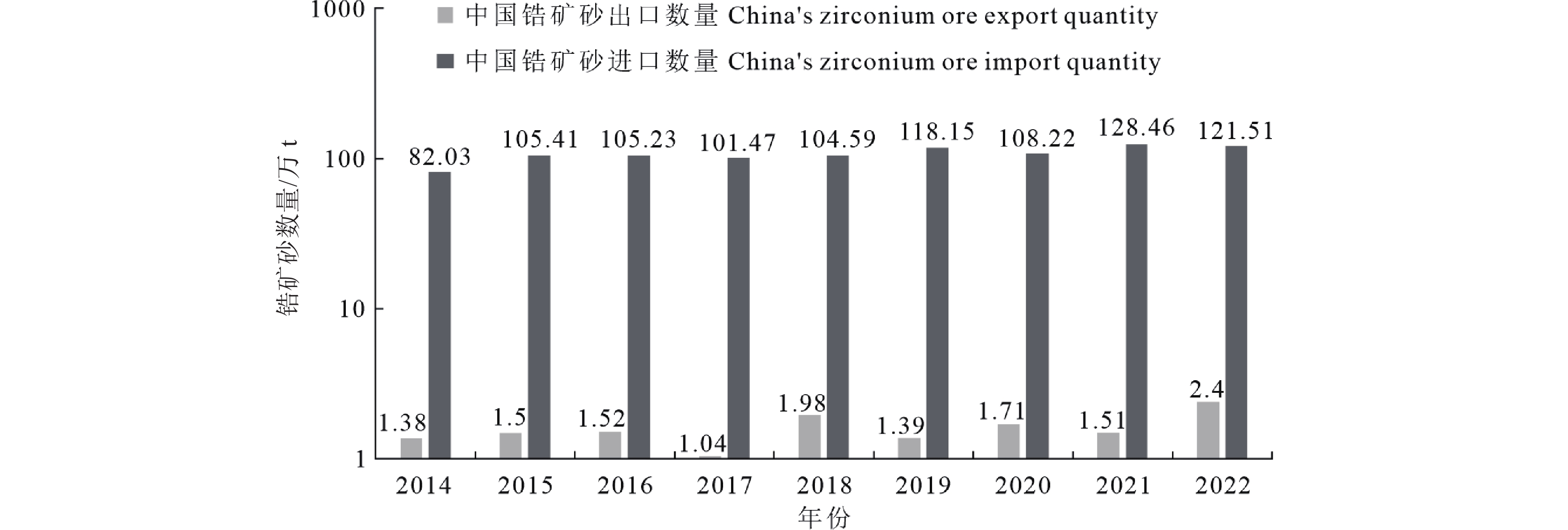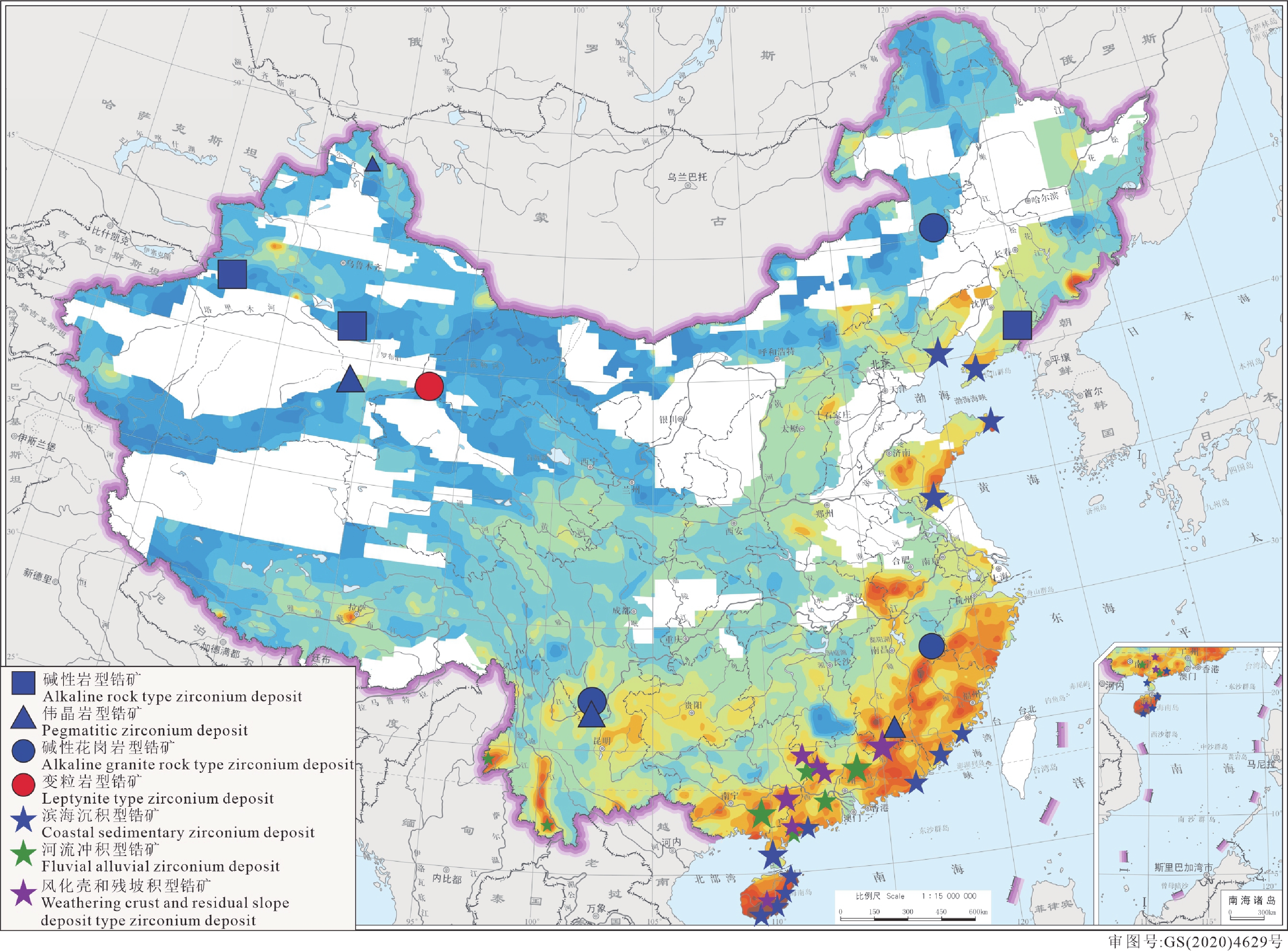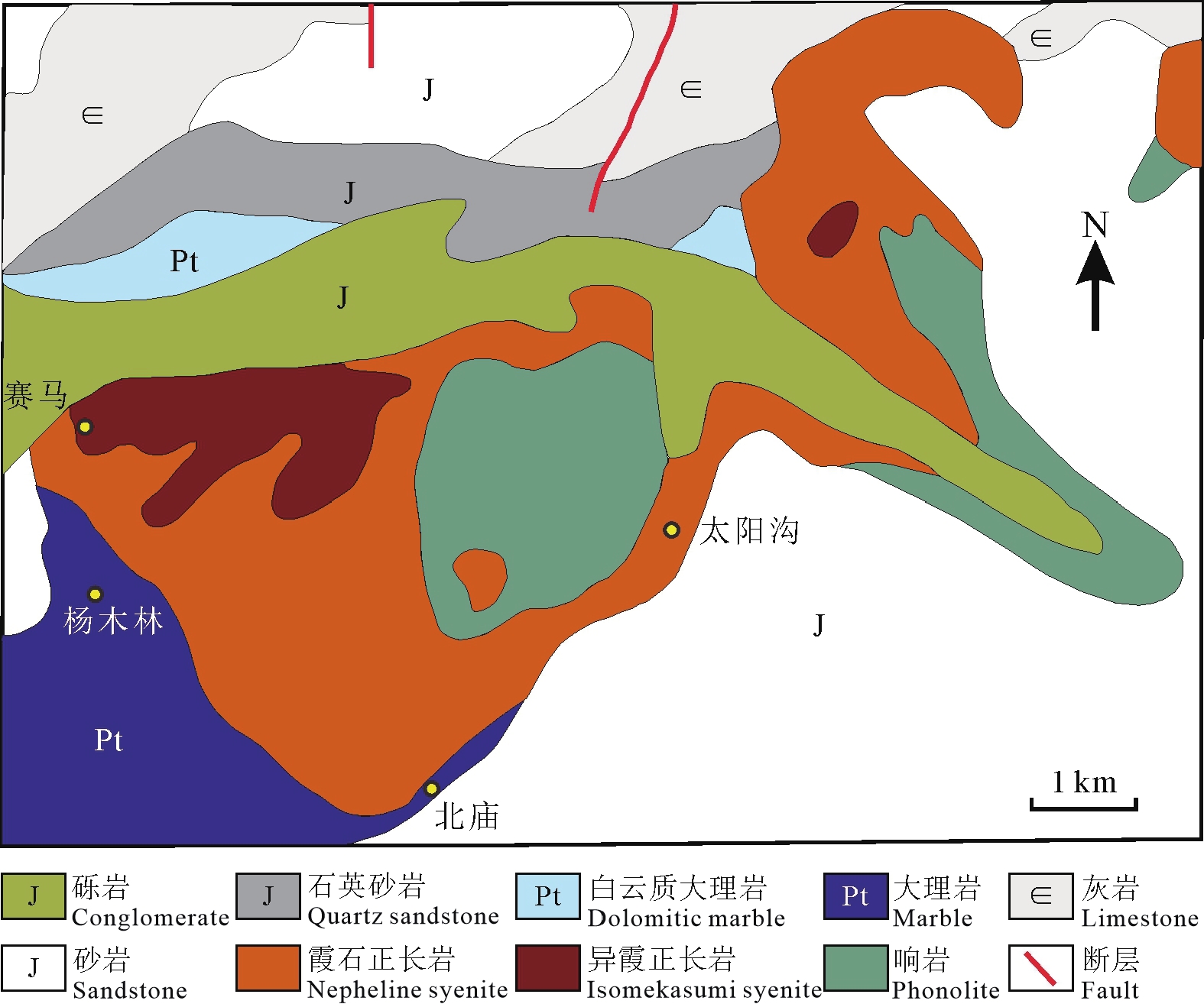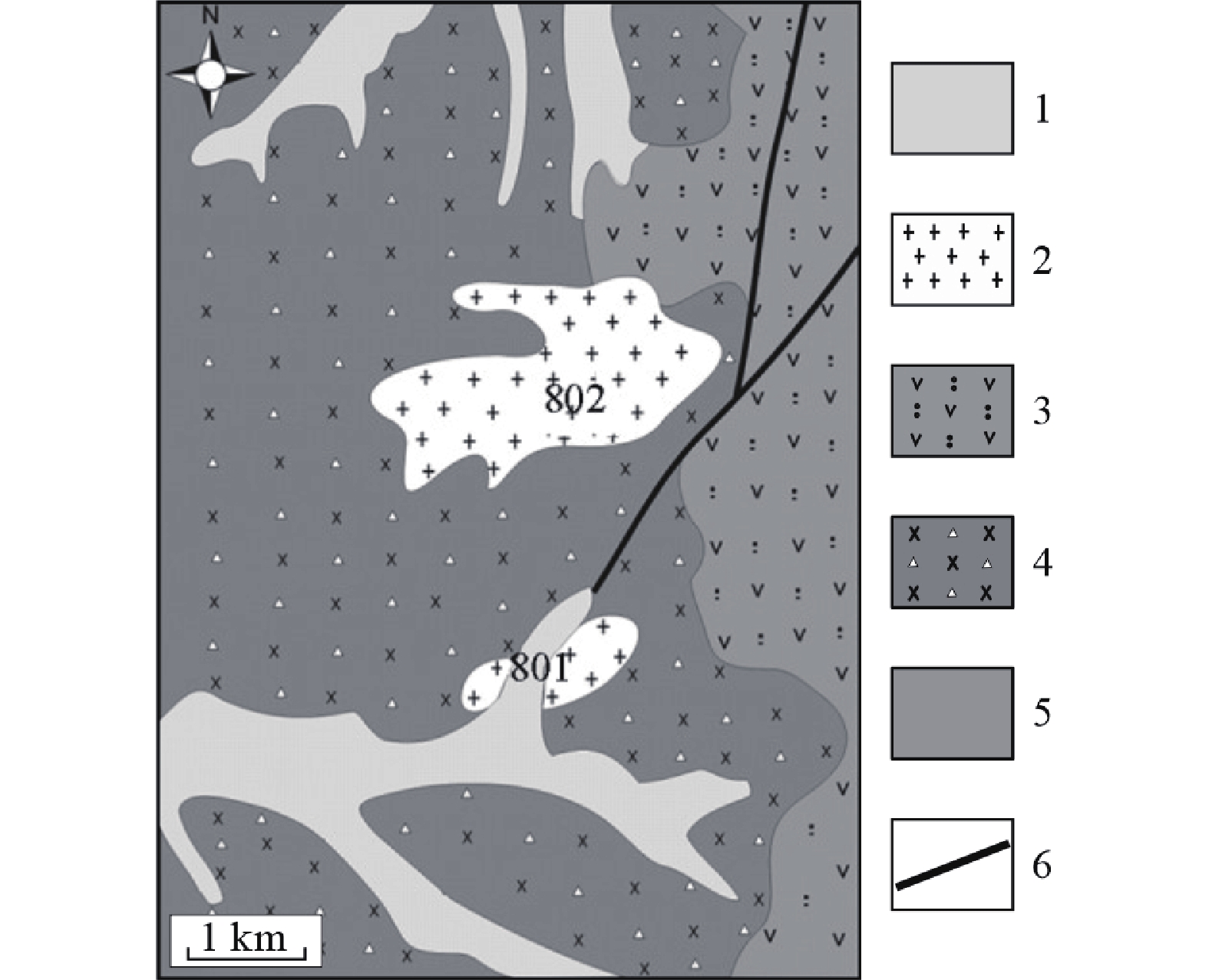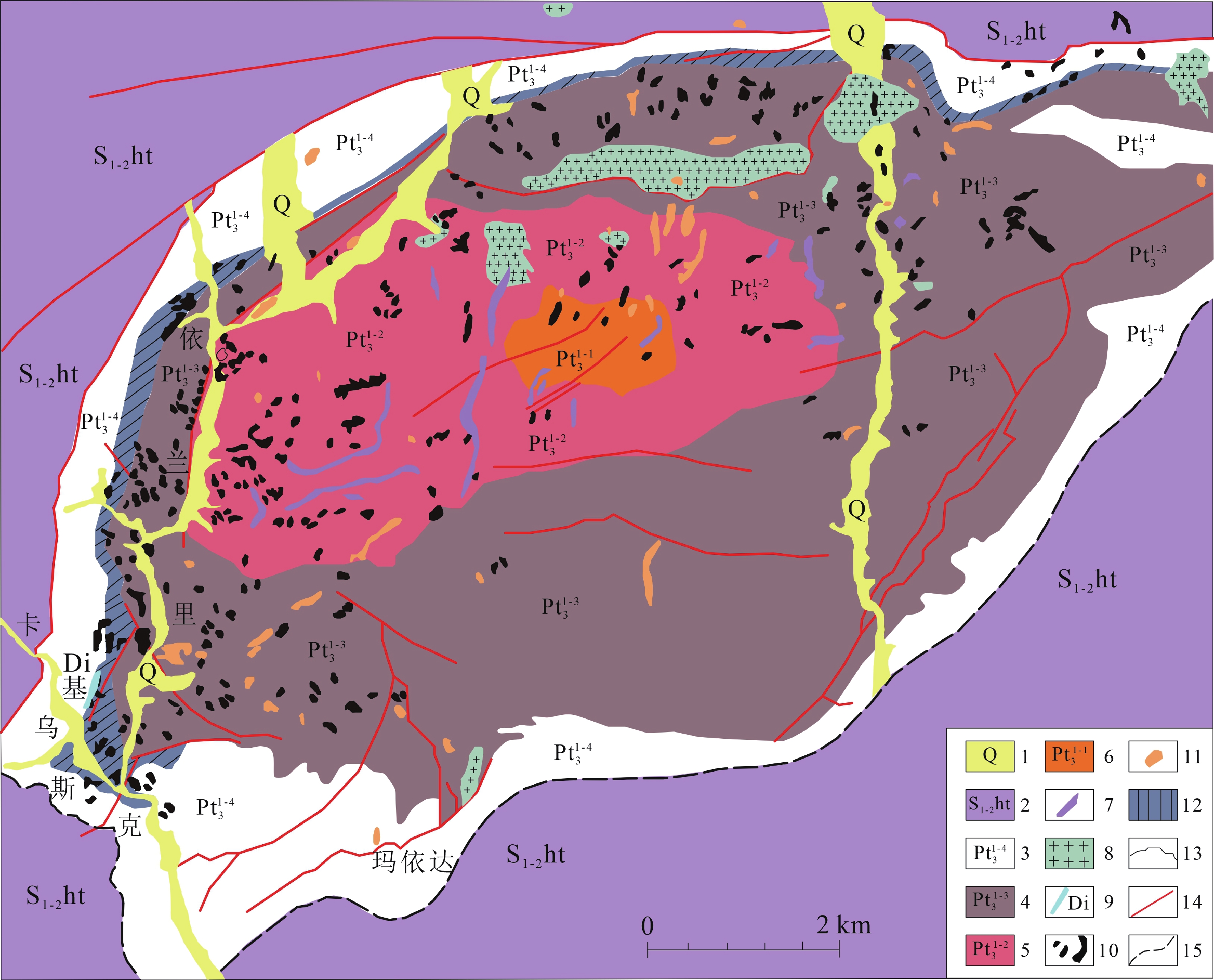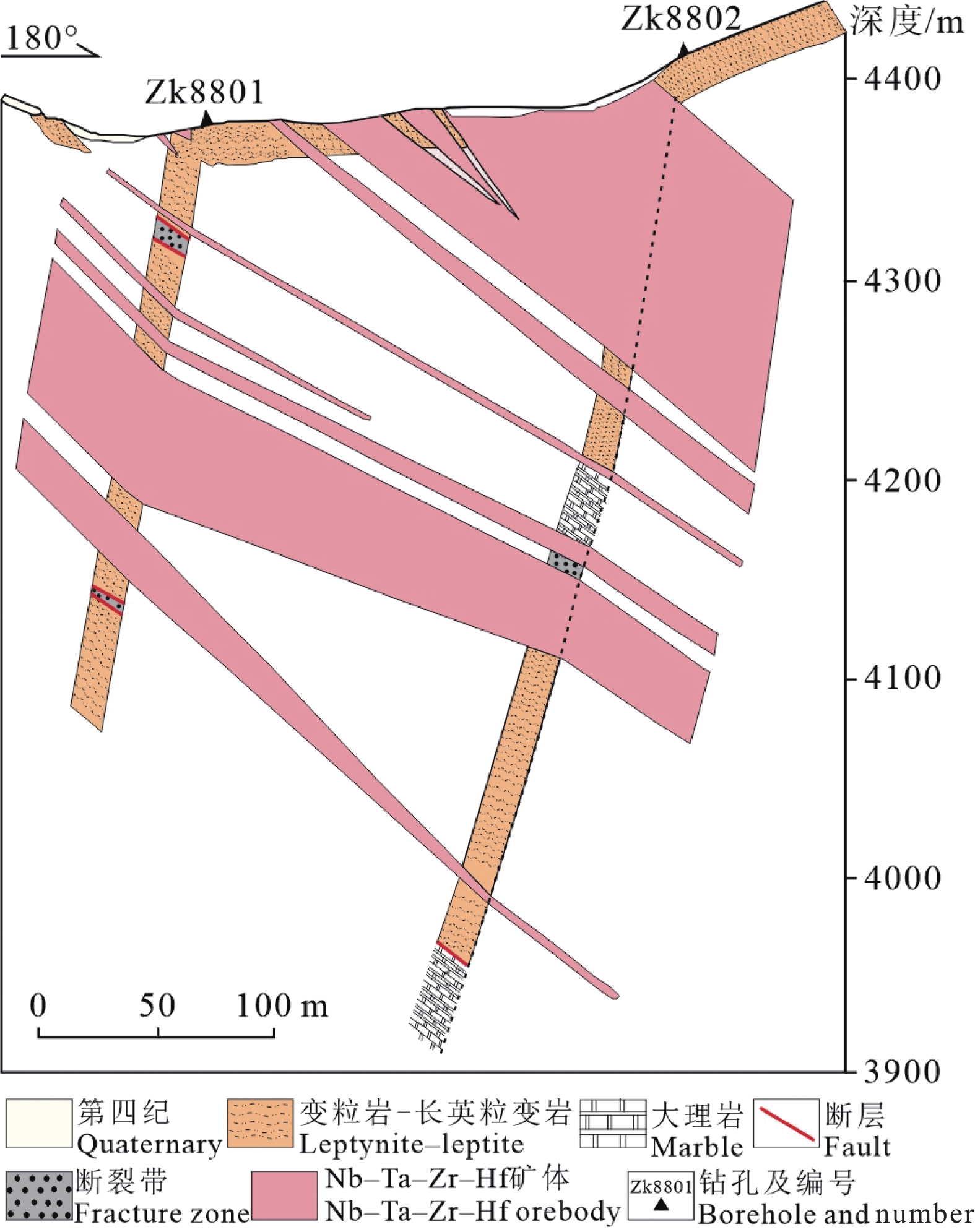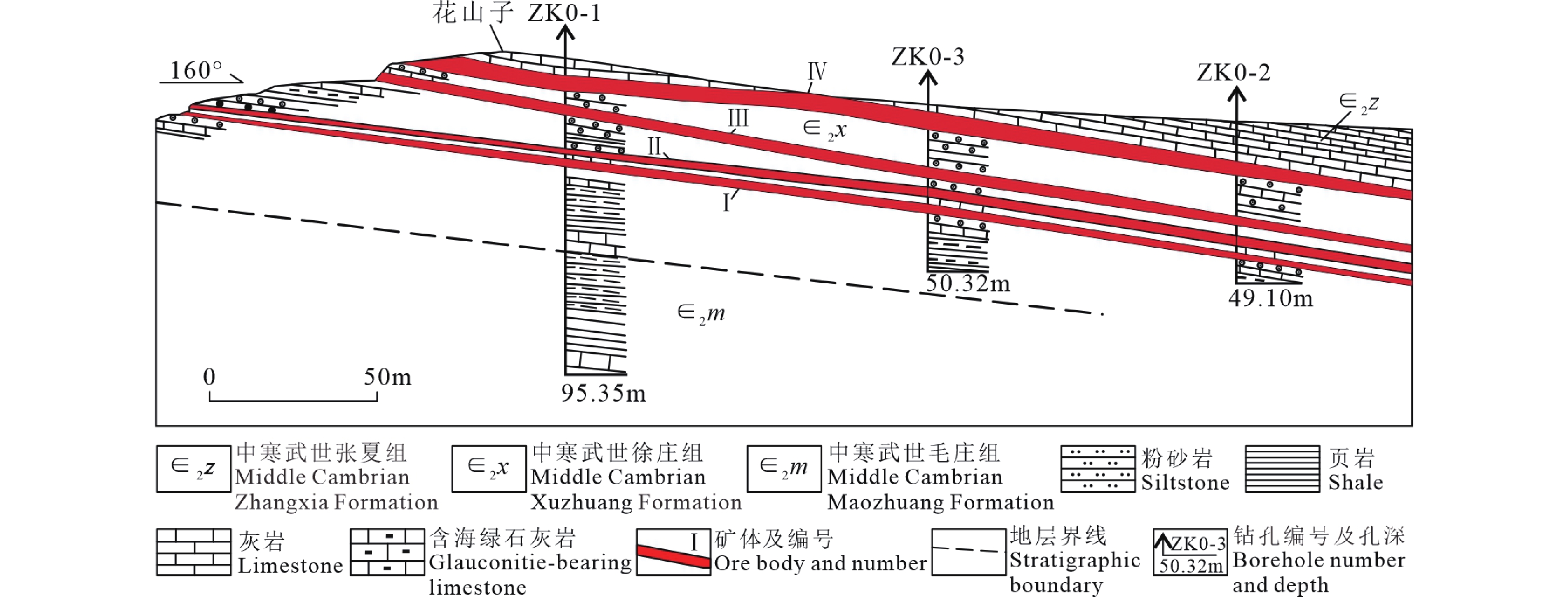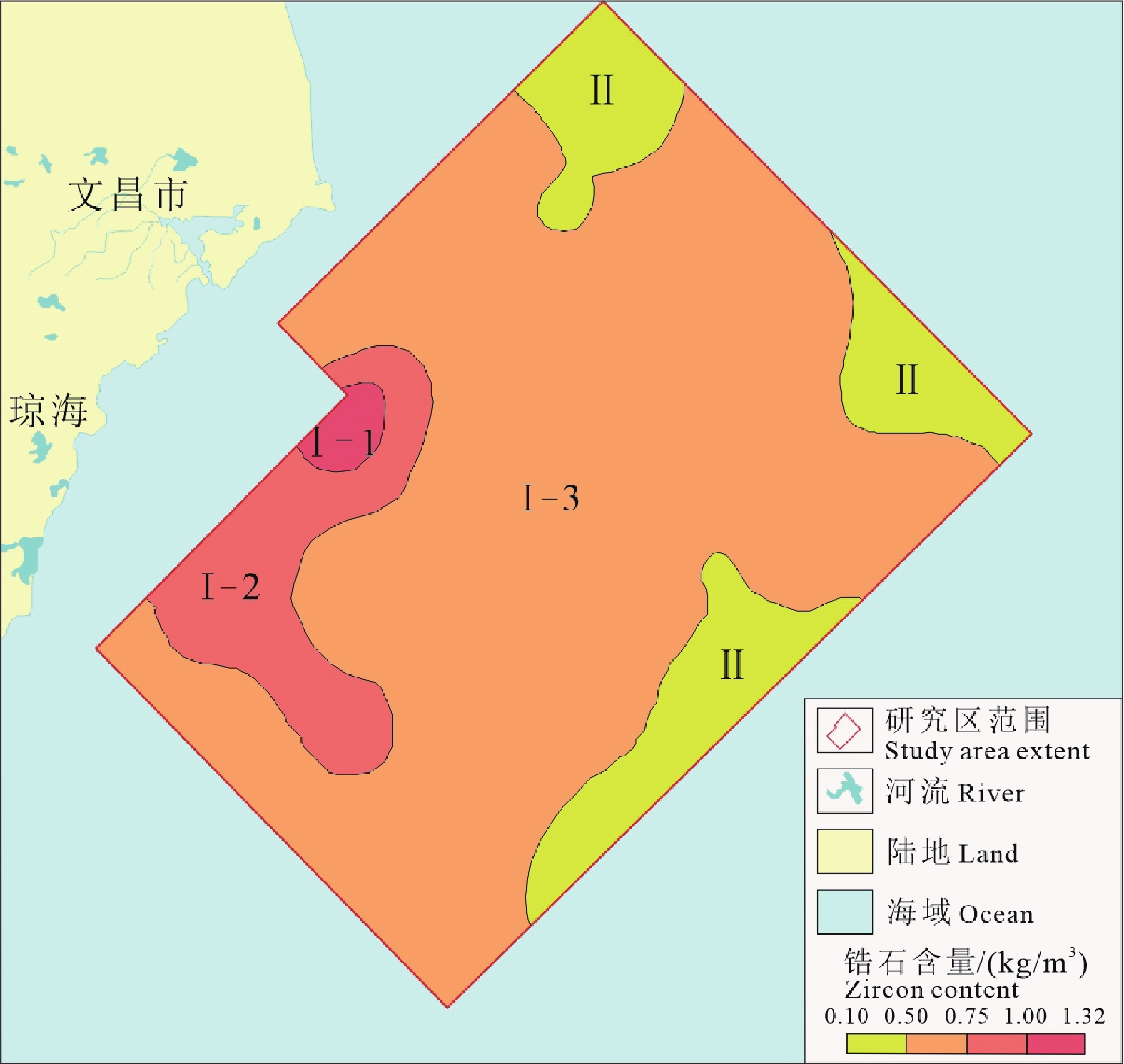Zircon resource characteristics, deposit types, key applications and prospecting prospects in China
-
摘要:
研究目的 锆是一种稀有金属,是关键金属矿产之一,因其耐高温、抗腐蚀、易加工、机械性能好、化学性质稳定等特点,锆金属和锆的化合物在军事工业、耐火材料、陶瓷等行业均有关键应用,锆石在地质定年和示踪岩浆源区方面应用广泛。
研究方法 本文通过收集整理总结前人研究资料,对中国锆矿资源分布、锆矿床类型特征以及锆金属及其合金的关键应用进行研究。
研究结果 中国锆矿床主要分布于内蒙古、海南、广东、云南和广西5省,这5个省区的锆矿储量之和占全国储量的97.6%。中国锆矿资源禀赋较差,储量约50万t(以ZrO2计),仅占全球储量的0.7%。中国每年锆矿需求量约120万t,但中国每年锆矿进口量约110万t,锆矿对外依赖程度高达90%以上。中国锆矿床可分为内生矿床和外生矿床两类,其中内生矿床可分为碱性花岗岩型、伟晶岩型、碱性岩型和变粒岩型,外生矿床可分为滨海沉积型、河流冲积型、风化壳和残坡积型。
结论 综合前人研究资料认为,内生矿床与碱性岩、碱性花岗岩、伟晶岩关系密切,塔里木—华北克拉通北缘断裂带和大兴安岭南段具有较大找矿潜力;外生矿床以砂矿床为主,主要分布于海南岛沿海地带、东南沿海地带和环渤海—黄海地带,海南岛东部海域、西部昌化江河口和胶东半岛东南沿海区有较大找矿潜力。
Abstract:This paper is the result of mineral exploration engineering.
Objective Zirconium is a rare metal and one of the key metal minerals. Because of its high temperature resistance, corrosion resistance, easy processing, good mechanical properties and stable chemical properties, zirconium metal and zirconium compounds have key applications in military industry, refractories, ceramics and other industries, and zircon is widely used in geological dating and tracing magma source areas.
Methods By collecting and summarizing the previous research data, this paper studies the distribution of zirconium ore resources, the characteristics of zirconium deposit types and the key applications of zirconium metal and its alloys in China.
Results Zirconium deposits in China are mainly distributed in Inner Mongolia, Hainan, Guangdong, Yunnan and Guangxi provinces, and the sum of the zirconium deposits in these five provinces accounts for 97.6% of the national reserves. Zirconium mine in China has a poor resource endowment, with a reserve of about 500000 tons (calculated by ZrO2), accounting for only 1% of the global reserves. China's annual demand for zirconium ore is about 1.2 million tons, but China's annual imports of zirconium ore are about 1.1 million tons, and the degree of external dependence of zirconium ore is as high as 90%. Zirconium deposits in China can be divided into endogenetic deposits and exogenetic deposits, among which endogenetic deposits can be divided into four types: alkaline granite, pegmatite, alkaline rock and granulite, while exogenetic deposits can be divided into three types: coastal deposit, river impact, weathering crust and eluvial deposit.
Conclusions Based on previous research data, endogenetic deposits are closely related to alkaline rocks, alkaline granites and pegmatites, and the northern margin fault zone of Tarim−North China Craton and the southern section of Daxing'anling Mountains have great prospecting potential. Exogenous deposits are mainly sand deposits, which are mainly distributed in the coastal zone of Hainan Island, the southeast coastal zone and the Bohai Sea–Yellow Sea zone. The eastern sea area of Hainan Island, the mouth of Changhua River in the west and the southeast coastal zone of Jiaodong Peninsula have great prospecting potential.
-

-
图 1 2022年全球锆储量分布图(据USGS, 2023)
Figure 1.
图 4 中国锆矿床分布图(底图为锆地球化学图,据王汝成等, 2020)
Figure 4.
图 5 辽宁赛马碱性岩体地质简图(据邬斌等, 2018修改)
Figure 5.
图 6 巴尔哲地区801超大型矿床和802未矿化岩体地质简图(据杨武斌等, 2011修改)
Figure 6.
图 7 新疆依兰里克地区碱性伟晶岩分布地质简图(据谢明材等, 2020修改)
Figure 7.
图 8 中国西北部甘肃省余石山Nb–Ta–Zr–Hf–REE矿床地质线88的横截面(根据Jiang et al., 2020修改)
Figure 8.
图 9 花山子矿床0号勘探线地质剖面(据冯学知, 2020修改)
Figure 9.
图 10 锆英石异常分布区(据宋家伟等, 2021修改)
Figure 10.
图 11 山东省滨海砂矿成矿远景区划图(据迟洪纪等, 2001修改)
Figure 11.
表 1 全球锆矿资源储量表(万t)(据USGS, 2023)
Table 1. Global zirconium resource reserves (104 t) (after USGS, 2023)
国家 锆矿年产量 锆矿储量(以ZrO2计) 2021 2022 澳大利亚 50 50 4800 南非 32 32 590 塞加内尔 6.4 7 260 莫桑比克 10 10 180 中国 14 14 50 美国 <10 <10 50 印度尼西亚 5.5 6 NA 其他国家 15 16 850 总量 130 140 6800 注:对澳大利亚来说,符合联合矿石储备委员会标准或同等储量的总重量为2400万t;NA代表不可用;总量不包括美国。 表 2 中国主要锆矿床及类型(数据来源王汝成等, 2020;中国矿产资源储量库)
Table 2. Main types of zirconium deposits in China (Data source: Wang Rucheng et al., 2020; Reserves of mineral resources in China)
序号 矿床名称 矿床类型 赋矿地质体 主要矿种 矿床规模 1 扎鲁特旗801稀土矿 碱性花岗岩型 钠长石化花岗岩 REE−Zr−Nb−Be 大型 2 四川德昌茨达褐钇钶砂矿床 碱性花岗岩型 碱性花岗岩 Y−Nb−Zr 小型 3 西昌莲花山、脚基坪铌钽矿 碱性花岗岩型 碱性花岗岩 Y−Nb−Ta−Zr 中型 4 江西横峰葛源黄山铌钽矿 碱性花岗岩型 钠长石化花岗岩 Nb−Ta−Zr−Hf 中型 5 江西石城海罗岭铌钽矿 伟晶岩型 蚀变花岗伟晶岩 Nb−Ta−Zr−W−Sn−Li−Rb 小型 6 江西横峰葛源黄山铌钽矿 伟晶岩型 钠长石化花岗岩−伟晶岩 Nb−Ta−Zr−Hf 中型 7 四川会理路枯201矿 伟晶岩型 碱性伟晶岩 REE−Nb−Ta−Zr 小型 8 新疆依兰里克 伟晶岩型 碱性伟晶岩 REE−Nb−Ta−Zr 中型 9 新疆可可托海 伟晶岩型 花岗伟晶岩 Li−Be−Nb−Ta−Zr−Hf 大型 10 莱西市塔埠头稀土矿 伟晶岩型 花岗伟晶岩 REE−Zr−U 小型 11 辽宁赛马 碱性岩型 异霞正长岩 REE−Nb−Ta−Zr 小型 12 新疆阔克塔格 碱性岩型 碱性正长岩 REE−Nb−Ta−Zr 小型 13 新疆拜城波孜果尔 碱性岩型 碱性正长岩 Nb−Ta−Zr−Hf−REE 小型 14 甘肃余石山 变粒岩型 变粒岩 REE−Nb−Ta−Zr 中型 15 山东荣成、桃园锆英砂矿 滨海沉积型 砂矿 Zr−Hf 小型 16 辽宁登沙河锆英石砂矿 滨海沉积型 砂矿 Au−Zr−Hf 小型 17 广东陆丰锆英石砂矿 滨海沉积型 砂矿 REE−Ti−Fe−Zr−Hf 小型 18 阳江市丹南独居石砂矿 滨海沉积型 砂矿 REE−Ti−Fe−Zr−Hf 中型 19 徐闻县柳尾砂钛矿 滨海沉积型 砂矿 REE−Ti−Fe−Zr−Hf 中型 20 海南文昌、琼海、万宁、陵水 滨海沉积型 砂矿 Ti−Fe−Zr−Hf 大型 21 广东龙门永汉、电白马店河 河流冲积型 砂矿 Nb−Fe−REE−Zr−Hf 大型 22 陆川白马磷钇矿 河流冲积型 砂矿 REE−Y−Nb−Zr−Hf 中型 23 勐海勐阿独居石矿 河流冲积型 砂矿 Ti−Fe−REE−Zr−Hf 大型 24 广西北流520矿 风化壳和残坡积型 变质花岗岩风化壳 REE−Zr−Hf 大型 25 湖南江华姑婆山(729矿) 风化壳和残坡积型 黑云母花岗岩风化壳 Nb−Y−Zr−Hf 中型 26 江西省龙南县塔背锆矿区 风化壳和残坡积型 黑云母花岗岩风化壳 Nb−Y−Zr−Hf 中型 27 全南县寨下大峰脑锆铪矿 风化壳和残坡积型 黑云母花岗岩风化壳 Nb−Y−Zr−Hf 小型 28 广东广宁512、513矿 风化壳和残坡积型 黑云母花岗岩风化壳 REE−Y−Zr−Hf 中型 表 3 重要的含锆矿物(据王瑞江等, 2015)
Table 3. Important zirconium–bearing minerals (after Wang Ruijiang et al., 2015)
矿物名称 化学组成 相对密度 硬度 颜色 ZrO2/% HfO2/ZrO2 斜锆石 ZrO2 5.5~6 6~6.5 白、黄、红 80~98 0.02 锆石 ZrSiO4 4.2~4.9 7.5 无、黄、粉红、紫、棕、蓝等 61~67 0.015~0.04 钛锆钍矿 (Ca,Fe)(Ti,Zr,Th)2O5 4.7 5.5 黑 52 0.01~0.027 锆钽矿 Mn,Ca等的硅(锆,钽)酸盐 4.8 6.5 黑、黑褐 20~30 0.006 硅钠钛矿 Na2O·2(Ti,Zr)O2·2SiO2 3.4 6 黑、褐紫 12 钾钙板锆石 K2CaZrSi4O12 3.1 无 21 钠锆石 H4(Na,Ca)ZrSi3O11 2.75 6 淡黄、黄褐 30~40 0.01 斜钠锆石 H6Na2Zr(SiO3)6 2.54 7 白、砖红 21 0.002 钙铝锆钛矿 Ca(Zr,Ti)2O5,其中有A12TiO5 黑 22 钛锆矿 3ZrO2·2TiO2·2H2O 黄绿 水硅钠钛石 Na,Fe,Mn,Ca的硅(铁,锆)酸盐 2~3 紫 异性石 Zr,Fe,Ca,Ce,Na等的偏硅酸盐,含Cl,化学式大致为(Na,Ca)2ZrSi6O17(O,OH,Cl) 2.9~3.0 5~5.5 紫、红、褐 12 0.01 表 4 锆化合物及用途(据王瑞江等, 2015)
Table 4. Zirconium compounds and applications (after Wang Ruijiang et al., 2015)
化合物 化学式 用途 二氧化锆 ZrO2 耐火材料、研磨材料、电子材料、陶瓷材料 氢化锆 ZrH2 反应堆减速剂、吸气剂、制备锆粉的原料 碳化锆 ZrC 高温耐火材料,生产二氧化锆的原料 氮化锆 ZrN 金属锆表面的硬质膜 氯氧化锆 ZrOCl2·8H2O 生产颜料的原料,媒染剂,瓷器翁结剂,生产各种锆化合物的原料 四氯化锆 ZrCl4 主产金属锆及化合物的原料,石油化学用催化剂 氟化锆 ZrF4 金属表面处理剂、催化剂,金属冶炼 锆氟酸钾 K2ZrF6 金属表面处理剂,生产铝、镜等的添加剂,生产金属锆的原料 六氟化锆 ZrF6 热裂催化剂 硫酸氧锆 ZrO·SO4 白色皮革轿剂,羊毛处理剂 碳酸锆钾 K2ZrO(CO3)2 消炎药 锆酸钙 CaZrO3 陶瓷电容器添加剂,喷镀材料 硅锆酸钠 Na4ZrSiO6 陶瓷原料,白皮革草草剂 氢氧化锆 ZrO(OH)2 耐火材料、稳定ZrO2的原料,除臭剂,吸附剂 乙酸锆 Zr(CH3COO)4 纤维用永久防水剂,各种纤维原料,催化剂 -
[1] Chi Hongji, Li Xiuzhang, Zheng Zuoping. 2001. Littoral placers forming rule and prospecting divisions in Shandong Province[J]. Geology of Shandong, 17(5): 24−31 (in Chinese with English abstract).
[2] Corfu, John M H, Paul W O H, Peter K. 2003. Atlas of zircon textures[J]. Reviews in Mineralogy and Geochemistry, 53(1): 469−500. doi: 10.2113/0530469
[3] Feng Runtang, Qin Yan, Deng Yongchao, Tan Xianpeng. 2004. Zirconium–containing raw materials and their application in refractory materials[J]. Rare Metals Letters, 23(6): 36−40 (in Chinese).
[4] Feng Xuezhi. 2020. Geological characteristics and prospecting direction of the Huashanzi ancient zirconium placer in Pizhou, Jiangsu Province[J]. East China Geology, 41(3): 256−264 (in Chinese with English abstract).
[5] Feng Zhihao, Xia Chaoqun, Zhang Xinyu, Ma Mingzhen, Liu Riping. 2018. Development and applications of zirconium alloys with high strength and toughness[J]. Materials Science and Technology, 26(2): 1−8 (in Chinese with English abstract).
[6] Force E R. 1991. Geology of titanium–mineral deposits[J]. Geological Society of America Special Paper, 259: 112.
[7] Force E R, Rich F J. 1989. Geologic evolution of Trail Ridge Eolian heavy–mineral sand and underlying peat, northern Florida[J]. U. S. Geological Survey Professional Paper, 1499: 16.
[8] Hamilton, Neil T M. 1995. Controls on the global distribution of coastal titanium–zirconium placers[J]. International Geology Review, 37(9): 755−779.
[9] Han Xiaohui, Li Liang, Liu Gang, Wang Xuemu. 2017. Occurrence characteristics of offshore Zi–Ti placer deposits in eastern Wanning of Hainan island[J]. China Mining Magazine, 26(S2): 186−189 (in Chinese with English abstract).
[10] Heaman L M, Bowins R, Crocket J. 1990. The chemical composition of igneous zircon suites: Implications for geochemical tracer studies[J]. Geochimica et Cosmochimica Acta, 54: 1597−1607. doi: 10.1016/0016-7037(90)90394-Z
[11] Heaman L M, LeCheminant A N. 1993. Paragenesis and U–Pb systematics of baddeleyite (ZrO2)[J]. Chemical Geology, 110: 95−126. doi: 10.1016/0009-2541(93)90249-I
[12] Hoskin P W, Schaltegger U. 2003. The composition of zircon and igneous and metamorphic petrogenesis[J]. Reviews in Mineralogy and Geochemistry, 53(1): 27−62.
[13] Huang Xinhong, Huang Huining. 2010. Application status and development prospect of zirconium silicate in traditional ceramics[J]. Foshan Ceramics, 20(1): 4−8 (in Chinese).
[14] Jia Yujie, Lin Xiheng, Zou Xiaowei, Han Weizhong. 2022. Research and development history, status and prospect of zirconium alloys[J]. Materials China, 41(5): 354−370 (in Chinese with English abstract).
[15] Jia Zhilei. 2016. Geochemical and metallogenetical characteristics of Nb−Ta−Rb deposits, South Qilian–Beishan area, Gansu Province, China[D]. Lanzhou: Lanzhou University, 1–164 (in Chinese with English abstract).
[16] Jiang S Y, Su H M, Xiong Y Q, Liu T, Zhu K, Zhang L. 2020. Spatial−temporal distribution, geological characteristics and ore−formation controlling factors of major types of rare metal mineral deposits in China[J]. Acta Geologica Sinica (English Edition), 94(6): 1757−1773. doi: 10.1111/1755-6724.14595
[17] Jiang S Y, Liu T, Zhang H X, Cao S Y, Zheng R H, Li T G, Yu J P, Wu Y B. 2022. A new type of rare metal deposit: The Yushishan leptynite–type Nb–Ta deposit in Eastern Altun, Gansu Province, NW China[J]. Acta Geologica Sinica (English Edition), 96(5): 1471−1483. doi: 10.1111/1755-6724.15010
[18] Klemme S, Meyer H P. 2003. Trace element partitioning between baddeleyite and carbonatite melt at high pressures and high temperatures[J]. Chemical Geology, 199: 233−242.
[19] Kogarko L N. 1990. Ore–forming potential of alkaline magmas[J]. Lithos, 26: 167−175. doi: 10.1016/0024-4937(90)90046-4
[20] Li Youfen, Wang Dewei, Wang Shufan. 2006. Zirconium diboride and its application in refractory[J]. Advanced Ceramics, (3): 26−30 (in Chinese with English abstract).
[21] Poitrasson F, Hanchar J M, Schaltegger U. 2002. The current state of accessory mineral research[J]. Chemical Geology, 191: 3−24. doi: 10.1016/S0009-2541(02)00146-8
[22] Pupin J P. 1980. Zircon and granite petrology[J]. Contributions to Mineralogy and Petrology, 73: 207−220.
[23] Ren Yongguo, Liu Ziqiang, Yang Kai, Zhou Huanzhong, Gu Xingyong. 2008. Kind and application of zirconia material[J]. China Ceramics, 44(4): 44−46 (in Chinese with English abstract).
[24] Rubatto D, Gebauer D, Compagnoni R. 1999. Dating of eclogite–facies zircons: The age of Alpine metamorphism in the Sesia–Lanzo zone (Western Alps)[J]. Earth and Planetary Science Letters, 167: 141−158. doi: 10.1016/S0012-821X(99)00031-X
[25] Saxena S K. 1966. Evolution of zircons in sedimentary and metamorphic rocks[J]. Sedimentology, 6: 1−33. doi: 10.1111/j.1365-3091.1966.tb01568.x
[26] Schaltegger U, Fanning C M, Günther D, Maurin J C, Schulmann K, Gebauer D. 1999. Growth, annealing and recrystallization of zircon and preservation of monazite in high–grade metamorphism: Conventional and in situ U–Pb isotope, cathodoluminescence and microchemical evidence[J]. Contributions to Mineralogy and Petrology, 134(2/3): 186−201.
[27] Scharer U, Fernando C, Daniel D. 1997. U–Pb and Lu–Hf isotopes in baddeleyite and zircon megacrysts from the Mbuji–Mayi kimberlite: Constraints on the subcontinental mantle[J]. Chemical Geology, 143: 1−16. doi: 10.1016/S0009-2541(97)00094-6
[28] Shi Minghua, Liu Caili, Zhou Jun, Tian Feng, Zhang Jianjun, Wang Wensheng, Li Zhongkui. 2015. Application of zirconium and its alloys in industry[J]. Hot Working Technology, 44(18): 28−30 (in Chinese with English abstract).
[29] Singer D A. 1992. Descriptive model of carbonatite deposits[J]. U. S. Geological Survey Bulletin, 1693: 51.
[30] Song Jiawei, Wu Deming, Chen Fei, Deng Kaizhang. 2021. Geochemical characteristics and resource potential of Zr and Ti in shallow sea surface sediments in the east of Hainan island[J]. China Mining Magazine, 30(S1): 217−221 (in Chinese with English abstract).
[31] Sun Hongwei, Wang Jie, Ren Junping, Zhang Weibo, Tang Wenlong, Fu Chao, Wu Xingyuan, Dang Zhicai. 2019. Present situation and utilization trend of zirconium resources in the world[J]. Conservation and Utilization of Mineral Resources, 39(5): 98−105 (in Chinese with English abstract).
[32] Sun Hongwei, Xu Kangkang, Zuo Libo, Ren Junping, Tang Wenlong, Gu Alei, Wu Xingyuan, Chipilauka Mukofu, Alphet Phaskani Dokowe. 2023. Distribution characteristics, types, supply-demand and development utilization status of zirconium and titanium resources[J]. Geology in China, 50(4): 1070−1081 (in Chinese with English abstract).
[33] Syre R P, Zhang Xiaoquan. 1987. Development of zirconium in Europe (1945–1984)[J]. Rare Metal Materials and Engineering, (2): 71−80 (in Chinese).
[34] Taylor S R, McLennan S M. 1995. The geochemical evolution of the continental crust[J]. Reviews of Geophysics, 33: 241−265. doi: 10.1029/95RG00262
[35] U. S. Geological Survey (USGC). 2023. Zirconium and Hafnium[C]// USGS Mineral Commodity Summaries, 202–203.
[36] Wang Denghong. 2019. Study on critical mineral resources: Significance of research, determination of types, attributes of resources, progress of prospecting, problems of utilization, and direction of exploitation[J]. Acta Geologica Sinica, 93(6): 1189−1209 (in Chinese with English abstract).
[37] Wang Denghong, Sun Yan, Dai Hongzhang, Guo Weiming, Zhao Zhi, Zhao Ting, Li Jiankang, Wang Chenghui, Huang Fan, Yu Yang, Li Dexian. 2019. Characteristics and exploitation of rare earth, rare metal and rare−scattered element minerals in China[J]. Strategic Study of CAE, 21(1): 119−127 (in Chinese with English abstract).
[38] Wang Denghong, Wang Ruijiang, Li Jiankang, Zhao Zhi, Yu Yang, Dai Jingjing, Chen Zhenghui, Li Dexian, Qu Wenjun, Deng Maochun, Fu Xiaofang, Sun Yan, Zheng Guodong. 2013. The progress in the strategic research and survey of rare earth, rare metal and rare−scattered elements mineral resources[J]. Geology in China, 40(2): 361−370 (in Chinese with English abstract).
[39] Wang Jingliang. 1997. Zircon and its application[J]. Multipurpose Utilization of Mineral Resources, (3): 43−49 (in Chinese with English abstract).
[40] Wang Lianhong. 2004. Development and application of zirconia oxygen sensor[J]. Shandong Ceramics, 27(2): 15−18 (in Chinese with English abstract).
[41] Wang Rucheng, Che Xudong, Wu Bin, Xie Lei. 2020. Critical mineral resources of Nb, Ta, Zr, and Hf in China[J]. Chinese Science Bulletin, 65(33): 3763−3777 (in Chinese with English abstract).
[42] Wang Ruijiang, Wang Denghong, Li Jiankang, Sun Yan, Li Dexian. 2015. Rare Earth, Rare Metal and Rare−scattered Element Mineral Resources and Their Development and Utilization[M]. Beijing: Geological Publishing House, 1−429 (in Chinese with English abstract).
[43] Wang Yixian, Zhao Zhenhua. 1997. Geochemistry and origin of the Baerzhe REE Nb–Be–Zr superlarge deposit[J]. Geochemistry, (1): 25–26, 28, 30–36 (in Chinese with English abstract).
[44] Wu B, Wang R C, Yang J H, Wu F Y, Zhang W L, Gu X P, Zhang A C. 2016. Zr and REE mineralization in sodic lujavrite from the Saima alkaline complex, northeastern China: A mineralogical study and comparison with potassic rocks[J]. Lithos, 262: 232−246. doi: 10.1016/j.lithos.2016.07.013
[45] Wu Bin, Wang Rucheng, Liu Xiaodong, Guo Guolin, Song Zhentao. 2018. Chemical composition and alteration assemblages of eudialyte in the Saima alkaline complex, Liaoning Province, and its implication for alkaline magmatic−hydrothermal evolution[J]. Acta Petrologica Sinica, 34(6): 1741−1757 (in Chinese with English abstract).
[46] Xie Mingcai, Su Benxun, Wang Zhongmei, Han Chunming. 2020. Research on the characteristics of rare and rare earth deposits associated with alkaline rocks in the northern margin of Tarim, Xinjiang[J]. Chinese Journal of Geology, 55(2): 420−438 (in Chinese with English abstract).
[47] Xing Shijun. 2009. Discussion about the geological characteristics of the Tabei weathering crust−type Zr, Hf deposit in Longnan County, Jiangxi Province[J]. Mineral Resources and Geology, 23(1): 70−72 (in Chinese with English abstract).
[48] Yang Wubin, Shan Qiang, Zhao Zhenhua, Luo Yong, Yu Xueyuan, Li Ningbo, Niu Hecai. 2011. Petrogenic and metallogenic action of the alkaline granitoids in Baerzhe Area: A comparison between mineralized and barren plutons[J]. Journal of Jilin University (Earth Science Edition), 41(6): 1689−1704 (in Chinese with English abstract).
[49] Yang Yi, Qi Rong, Liu Xiujuan, He Yusheng, Zhang Gucheng. 2010. Mineralization prospect of Zr and Ti and analysis of metallogenic conditions at the Changhua River estuary and its adjacent sea area in Hainan[J]. Geological Science and Technology Information, 29(1): 80−85 (in Chinese with English abstract).
[50] Yu Junpeng, Wu Yibu, Liang Minghong, Xiao Peixi, Dou Xiaoyu. 2015. New progress of the southern Altyn Tagh geological mapping and guide the prospecting support: According to 1: 50000 Mobeier and other five regional geological maps in Gansu Province[J]. Geological Survey of China, 2(2): 40−47 (in Chinese with English abstract).
[51] Yuan Zhongxin, Li Jiankang, Wang Denghong. 2012. Metallogenic Regularity of Rare Earth Deposits in China[M]. Beijing: Geological Publishing House, 1–135 (in Chinese with English abstract).
[52] Zhang Jianwen, Wang Haidong, Gong Wenyong, Ma Chongzhen, Zhang Hua, Liao Qian. 2019. Analysis on the development and utilization situation of zirconium resource in China[J]. Conservation and Utilization of Mineral Resources, 39(5): 106−110 (in Chinese with English abstract).
[53] Zhang Zhenfang, Chen Xiufa, Gao Aihong, Zhang Zhenguo. 2019. Analysis of the zirconium resource situation and global layout[J]. China Mining Magazine, 28(4): 50−56 (in Chinese with English abstract).
[54] Zhong Yufang, Ma Changqian, She Zhenbing. 2006. Geochemical characteristics of zircon and its applications in geosciences[J]. Geological Science and Technology Information, 25(1): 27−34,40 (in Chinese with English abstract).
[55] 迟洪纪, 李秀章, 郑作平. 2001. 山东省滨海砂矿成矿规律及远景区划[J]. 山东地质, 17(5): 24−31.
[56] 冯润棠, 秦岩, 邓永超, 覃显鹏. 2004. 含锆原料及其在耐火材料中的应用[J]. 稀有金属快报, 23(6): 36−40.
[57] 冯学知. 2020. 江苏邳州花山子古锆砂矿地质特征及找矿方向[J]. 华东地质, 41(3): 256−264.
[58] 冯志浩, 夏超群, 张新宇, 马明臻, 刘日平. 2018. 高强韧锆合金的发展与应用[J]. 材料科学与工艺, 26(2): 1−8. doi: 10.11951/j.issn.1005-0299.20170022
[59] 韩孝辉, 李亮, 刘刚, 王雪木. 2017. 海南岛万宁东部近海锆钛砂矿赋存特征[J]. 中国矿业, 26(S2): 186−189.
[60] 黄芯红, 黄惠宁. 2010. 硅酸锆在传统陶瓷中的应用现状及发展前景[J]. 佛山陶瓷, 20(1): 4−8. doi: 10.3969/j.issn.1006-8236.2010.01.002
[61] 贾豫婕, 林希衡, 邹小伟, 韩卫忠. 2022. 锆合金的研发历史、现状及发展趋势[J]. 中国材料进展, 41(5): 354−370. doi: 10.7502/j.issn.1674-3962.202112010
[62] 贾志磊. 2016. 甘肃南祁连—北山铌钽铷等稀有金属成矿地质特征与成矿规律的研究[D]. 兰州: 兰州大学, 1–164.
[63] 李友芬, 王德伟, 王舒凡. 2006. 二硼化锆及其在耐火材料中应用[J]. 现代技术陶瓷, (3): 26−30. doi: 10.3969/j.issn.1005-1198.2006.03.006
[64] 任永国, 刘自强, 杨凯, 周焕忠, 顾幸勇. 2008. 氧化锆材料种类及应用[J]. 中国陶瓷, 44(4): 44−46. doi: 10.3969/j.issn.1001-9642.2008.04.014
[65] 石明华, 刘彩利, 周军, 田锋, 张建军, 王文生, 李中奎. 2015. 锆及锆合金在工业领域的应用[J]. 热加工工艺, 44(18): 28−30.
[66] 宋家伟, 伍德明, 陈飞, 邓开章. 2021. 海南岛东部浅海表层沉积物锆、钛地球化学特征及资源潜力分析[J]. 中国矿业, 30(S1): 217−221. doi: 10.12075/j.issn.1004-4051.2021.S1.101
[67] 孙宏伟, 王杰, 任军平, 张伟波, 唐文龙, 付超, 吴兴源, 党智财. 2019. 全球锆矿资源现状与利用趋势[J]. 矿产保护与利用, 39(5): 98−105.
[68] 孙宏伟, 许康康, 左立波, 任军平, 唐文龙, 古阿雷, 吴兴源, Chipilauka Mukofu, Alphet Phaskani Dokowe. 2023. 锆–钛矿产资源分布特点、类型、供需格局及开发利用现状[J]. 中国地质, 50(4): 1070−1081.
[69] Syre R P, 张孝全. 1987. 欧洲锆的发展(1945–1984年)[J]. 稀有金属材料与工程, (2): 71−80.
[70] 汪镜亮. 1997. 锆英石及其应用[J]. 矿产综合利用, (3): 43−49.
[71] 王登红. 2019. 关键矿产的研究意义、矿种厘定、资源属性、找矿进展、存在问题及主攻方向[J]. 地质学报, 93(6): 1189−1209. doi: 10.3969/j.issn.0001-5717.2019.06.003
[72] 王登红, 孙艳, 代鸿章, 郭唯明, 赵芝, 赵汀, 李建康, 王成辉, 黄凡, 于扬, 李德先. 2019. 我国“三稀矿产”的资源特征及开发利用研究[J]. 中国工程科学, 21(1): 119−127.
[73] 王登红, 王瑞江, 李建康, 赵芝, 于扬, 代晶晶, 陈郑辉, 李德先, 屈文俊, 邓茂春, 付小方, 孙艳, 郑国栋. 2013. 中国三稀矿产资源战略调查研究进展综述[J]. 中国地质, 40(2): 361−370. doi: 10.3969/j.issn.1000-3657.2013.02.001
[74] 王连红. 2004. ZrO2氧传感器的发展与应用[J]. 山东陶瓷, 27(2): 15−18. doi: 10.3969/j.issn.1005-0639.2004.02.004
[75] 王汝成, 车旭东, 邬斌, 谢磊. 2020. 中国铌钽锆铪资源[J]. 科学通报, 65(33): 3763−3777.
[76] 王瑞江, 王登红, 李建康, 孙艳, 李德先. 2015. 稀有稀土稀散矿产资源及其开发利用[M]. 北京: 地质出版社, 1−429.
[77] 王一先, 赵振华. 1997. 巴尔哲超大型稀土铌铍锆矿床地球化学和成因[J]. 地球化学, 26(1): 25–26, 28, 30–36.
[78] 邬斌, 王汝成, 刘晓东, 郭国林, 宋振涛. 2018. 辽宁赛马碱性岩体异性石化学成分特征及其蚀变组合对碱性岩浆–热液演化的指示意义[J]. 岩石学报, 34(6): 1741−1757.
[79] 谢明材, 苏本勋, 王忠梅, 韩春明. 2020. 塔里木北缘与碱性岩有关的稀有—稀土矿床成矿作用研究[J]. 地质科学, 55(2): 420−438. doi: 10.12017/dzkx.2020.028
[80] 幸世军. 2009. 浅析江西省龙南塔背风化壳型锆铪矿床地质特征[J]. 矿产与地质, 23(1): 70−72. doi: 10.3969/j.issn.1001-5663.2009.01.014
[81] 杨武斌, 单强, 赵振华, 罗勇, 于学元, 李宁波, 牛贺才. 2011. 巴尔哲地区碱性花岗岩的成岩和成矿作用: 矿化和未矿化岩体的比较[J]. 吉林大学学报(地球科学版), 41(6): 1689−1704.
[82] 杨奕, 齐荣, 刘秀娟, 何玉生, 张固成. 2010. 海南岛昌化江河口与邻近海域锆、钛矿化远景及成矿地质条件分析[J]. 地质科技情报, 29(1): 80−85.
[83] 余君鹏, 吴义布, 梁明宏, 校培喜, 窦小雨. 2015. 阿尔金南缘地质填图新进展及对找矿的启示—据甘肃1∶5万莫坝尔等六幅区调[J]. 中国地质调查, 2(2): 40−47.
[84] 袁忠信, 李建康, 王登红. 2012. 中国稀土矿床成矿规律[M]. 北京: 地质出版社, 1–135.
[85] 张建文, 王海东, 龚文勇, 马崇振, 张华, 廖乾. 2019. 中国锆矿资源开发利用形势分析[J]. 矿产保护与利用, 39(5): 106−110.
[86] 张振芳, 陈秀法, 高爱红, 张振国. 2019. 锆资源形势分析及全球布局[J]. 中国矿业, 28(4): 50−56.
[87] 钟玉芳, 马昌前, 佘振兵. 2006. 锆石地球化学特征及地质应用研究综述[J]. 地质科技情报, 25(1): 27−34,40.
-



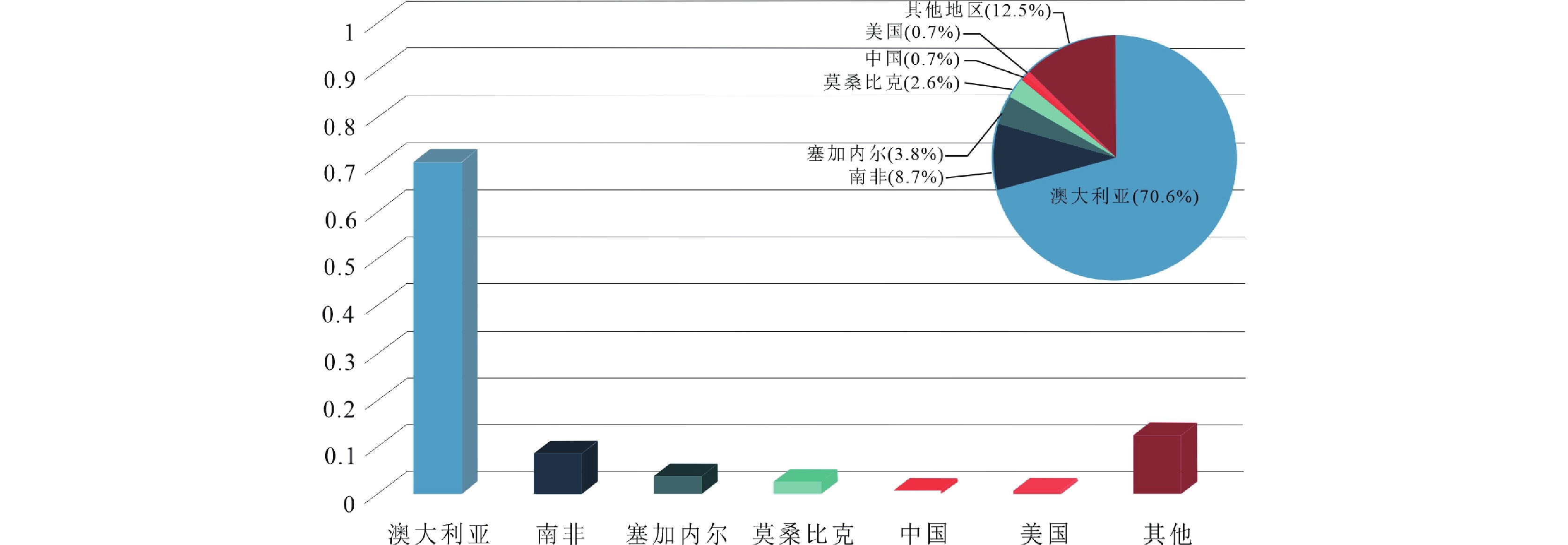
 下载:
下载:
